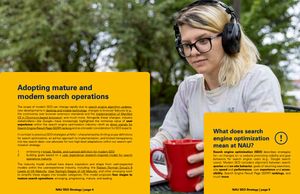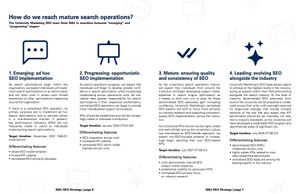
← Dev and technical SEO portfolio
NAU search optimization strategy refresh
I created NAU's first-ever university-wide SEO strategy to focus on meeting enrollment goals, expanding content strategy, and building search-friendly products. I also created a 17-page SEO strategy document—including writing, design, and remediation for accessibility—to help socialize the plan.
NAU SEO strategy at a glance
Defines and expands SEO scope to match enrollment goals.
Search engine optimization (SEO) describes strategies for—or changes to—a website promoting visibility and goal behaviors for search engine users (e.g., Google search users).
Establishes a 10-year maturity model for the university's organic search program.
I believe NAU is in transition between “emerging” and “progressing” stages. As search operations progress, I aim to cultivate an environment where individuals develop greater confidence in search optimization while increasingly collaborating across operational units.
Identifies key areas for improvement through content strategy, research and technical optimization, and training.
Priorities identified in the strategy include optimization of degree information pages, operational enhancements to WordPress theme migration processes, refinements to the WordPress theme development cycle, and investment in training and tools to support a data-informed culture.

Successes & failures
What's gone really well?
NAU's degree-search.nau.edu has absolutely taken off since the launch of our refreshed SEO strategy. While the site was launched in December 2021 without planning for many SEO best practices and architecture considerations, we have improved the technical SEO and content strategy of our site to allow for significant growth.
We've made targeted optimizations to degree search throughout the past year. As a result, I have seen consistent improvement in search KPIs and on-page user engagement metrics. However, this site continues to be a high priority for improvement.
Daily "degree search" clicks and impressions over one year
Google Search Console.
Last updated
What could've gone better?
Our "degree search" outperforms all our other products in terms of user-focused features, request for information form submission, and overall engagement —but it still falls behind in terms eyeballs. We've known from day one this would be a challange. We have a complex ecosystem of cannibalization-heavy content at NAU, and we can't just turn it off.
As of November 2023, I estimated that degree-search.nau.edu accounts for approximately 16% of all page views and 18% of active users—all in lead-generating sessions on the nau.edu website. While these metrics may seem relatively low, this makes degree-search.nau.edu the #1 top nau.edu site for generating leads that does not act as a destination for RFI links (e.g., excluding degrees.nau.edu, nau.edu/legacy, and nau.edu/request-information).
90-day breakdown of clicks to degree-information sources
Google Search Console.
Last updated
Highlights of FY24 NAU SEO strategy
3 pillars of NAU SEO program
Education & awareness
Investing in our people. We promote robust education in SEO best practices among existing and developing stewards of our web assets—including department site stewards—within University Marketing and across the broader institution, generating a high level of professional expertise in organic traffic generation throughout the university’s digital workforce.
Existing workstreams
Identifying optimal areas for improvement. We position the majority of SEO implementation alongside existing, prioritized workstreams (including ongoing site migrations, new content development, and content marketing opportunities like blog publishing) to best accommodate the needs of current and future students through search media.
Research & development
Creating a data-driven culture. We back up our education and implementation initiatives with innovative research, testing, and development—led by University Marketing’s in-house SEO team and supported by approved external partners. This research empowers NAU to leverage individualized benchmarks, insights, and implementation strategies that complement and refine existing university processes.
Stages to mature search operations at NAU
Based on existing models for maturity within user experience and SEO fields, I identified four distinct phases to search maturity that I expect will apply at NAU. I also expect that NAU is currently between the "emerging" and "progressing" phases that I identify here:
-
Emerging: ad hoc SEO implementation
Target timeline:
December 2021 -
Progressing: opportunistic SEO implementation
Target timeline:
January 2024 -
Mature: ensuring quality and consistency of SEO
Target timeline:
July 2027 -
Leading: evolving SEO alongside the industry
Target timeline:
July 2035
